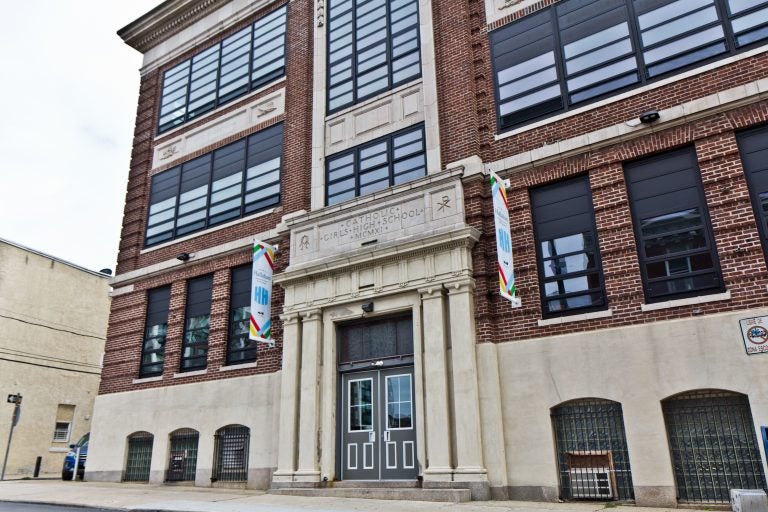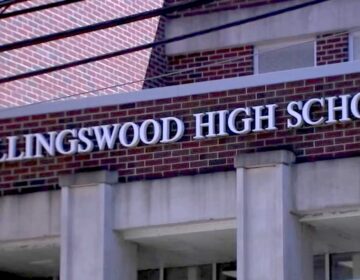‘Protect our legacy!’ How a public school crisis exposed a rift in the Philly Catholic school community
“No outsiders should be allowed.” Some Catholic school parents freaked out when their school thought about taking in public school kids.
Listen 1:29
John W. Hallahan Catholic Girls’ High School in Center City. (Kimberly Paynter/WHYY)
The signatures piled up and the comments poured in.
“No outsiders should be allowed…”
“I pay to send my daughters to Hallahan…”
“This petition is shameful.”
“Send them to Southern!”
“As an alum, I’m ashamed…”
“I’m all for helping others but…”
On the website, Change.org, a woman identifying herself as an alum of John W. Hallahan Catholic Girls High School in Center City, Philadelphia posted a petition on Oct. 10 with an urgent, bolded warning.
“HALLAHAN Alumni Protect our Legacy! STOP the relocation of Public school students to HH.”
The petition came shortly after administrators at Hallahan sent a letter to parents and guardians floating the idea of temporarily loaning some of their space to students from Science Leadership Academy (SLA).
Students from SLA — a selective, often sought-after public magnet school — have been exiled from their home building due to the discovery of asbestos in the school’s boiler room. In a desperate search to find new spaces for SLA’s 500 marooned children, the School District of Philadelphia and the Archdiocese of Philadelphia briefly considered a partnership.
Hallahan officials assured parents and guardians that SLA, a co-ed school, would remain in its “own distinct spaces” if indeed the contingency plan came to fruition. The relocation would have likely lasted less than three months.
“Please bear in mind that there are young people in need and they are just like the young women you entrust us to educate,” read the letter from President Denise Kassekert and Principal Sean Murray. “All of us have a duty to help those in need.”
‘Invade our space’
Reaction to the plan was swift and strong, exposing divides within the Hallahan community and highlighting the hostility toward Philadelphia’s public school system that drives some parents to choose Catholic education.
As some families and alum put it, maintaining separate classrooms and curricula wasn’t sufficient. Their daughters could not mix, on any level, with students from outside the Catholic system.
“Why are they coming to the Catholic schools and trying to invade our space,” asked Kelly Link, a South Philadelphian whose daughter is a senior at Hallahan, in an interview. “I’m not happy with it and I do not want other kids coming into her school.”
It seems Link no longer has to worry about that prospect.
About 700 people had signed the anti-SLA petition by mid-day Thursday when the School District announced that SLA students would use both district headquarters and a nearby synagogue as a temporary space until their building was remediated.
That hasn’t seemed to slow the Hallahan petition’s momentum. Nor has a clarifying Facebook post in the Hallahan alumnae group written by a woman claiming she created the petition in the first place.
“Upon receiving more details that provided context, I am not in support of the actions the petition supported,” the woman wrote.
Nevertheless, the petition had amassed more than 1,200 signatures by late Friday afternoon.
Many of the signers said it would be unfair to allow public school students to use Hallahan space when parents had paid roughly $9,000 to send their children to Catholic school. Others felt allowing a co-ed public school into the space would violate Hallahan’s legacy of single-sex education.
Then there were those who felt that the co-location of public school students with private counterparts would create disruptions and denigrate the Hallahan community.
“Hallahan has a great tradition, please do not let the School District of Philadelphia destroy it like all of its other schools,” wrote Mary Dougherty of Plymouth Meeting, who graduated from Hallahan in 1989.
‘Embarrassing’
But other Hallahan alum, like Eileen McCafferty DiFranco, believe those fears are bogus — and reveal deeper biases.
“For me, it’s just another manifestation of prejudice,” said DiFranco, class of 1970.
DiFranco, a retired city public school nurse, believes part of the allure of Catholic education is it allows families to isolate themselves from people they see as different. She believes bigotry drives some families to pick Catholic education — a point proven, she says, by the SLA backlash.
“[Catholic education] became a bastion for white people to take their kids out of the public school system,” said DiFranco, in part describing her own parents’ decision.
Slightly more than half of Hallahan students are white, according to federal data. SLA’s racial makeup is not dramatically different. Just under 40% of SLA students are white.
But the public system as a whole in Philadelphia is largely black and Hispanic. That’s the case at Benjamin Franklin High, the other school displaced by the discovery of asbestos.
DiFranco thinks some families see the words “public school” and associate them with an undesirable “other.”
“‘We don’t want them in our neighborhood,’” she said, guessing other parents’ motives. “‘We don’t want them in our schools because they’re gonna make things bad for my sweet, little child who’s here.”’
DiFranco actually credits Hallahan for broadening her sense of humanity. Growing up in the mostly white neighborhood of Port Richmond, DiFranco didn’t go to school with almost any non-white peers until she went to Hallahan.
“I can’t say that it was the Garden of Eden,” she said. “But for me, it changed my life.”
Philadelphia’s Catholic schools have become more diverse in recent decades, and some embrace the opportunity to serve more black and brown families.
Some Hallahan alum said they’re deeply disappointed with the backlash to the SLA proposal.
“The move needed to happen so quickly and I don’t think the over 100-year-old traditions of the school could react fast enough,” said Rosemary Harley, a Hallahan alum whose child is a freshman at SLA. “But it is embarrassing to have the more vocal alumnae disparaging kids that need a building to learn in.”
The school district denies that opposition from the Hallahan community ultimately scuttled the proposal. They say that the Rodeph Shalom site, which does not have a K-12 school, was the preferred option among SLA parents and faculty on a relocation task force.
“After a thorough discussion among the Task Force members, Rodeph Shalom was identified as the site that would best serve the needs of SLA students,” the district said through a spokesperson.
Still, the internal dialogue among the Hallahan community has drawn out deeper questions. Who is Catholic education for? What values should define it and what should it expect from its community?
Kelly Link stands firm in her beliefs.
She says her daughter spent two miserable years at a public charter school in South Philadelphia, and she doesn’t think students treat teachers with proper respect in public schools.
Allowing SLA students into the building could have created conflicts, Link thinks, and she’s upset Hallahan administrators mulled the idea before running it by parents.
Link says going to Hallahan connects students to generations of success — and that it’s important Hallahan girls get the “moral” education a Catholic school provides.
She says she’s sensitive to the needs of displaced public school students, and feels bad that SLA kids had to leave their home building.
But she also feels it’s unfair for the school district to ask a small, all-girls Catholic school to fix a problem created by the district’s own failures.“Take care of your own,” Link said. “Take care of the city children.”
WHYY is your source for fact-based, in-depth journalism and information. As a nonprofit organization, we rely on financial support from readers like you. Please give today.





